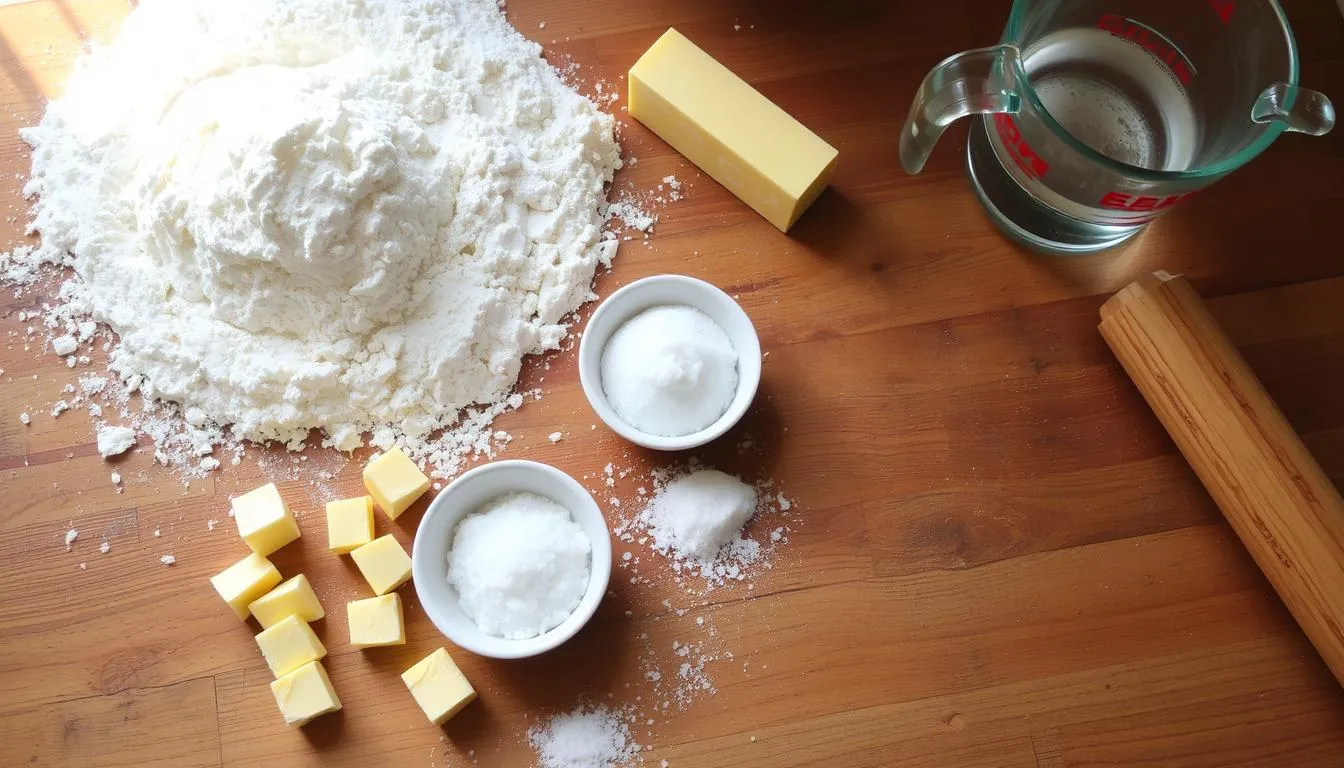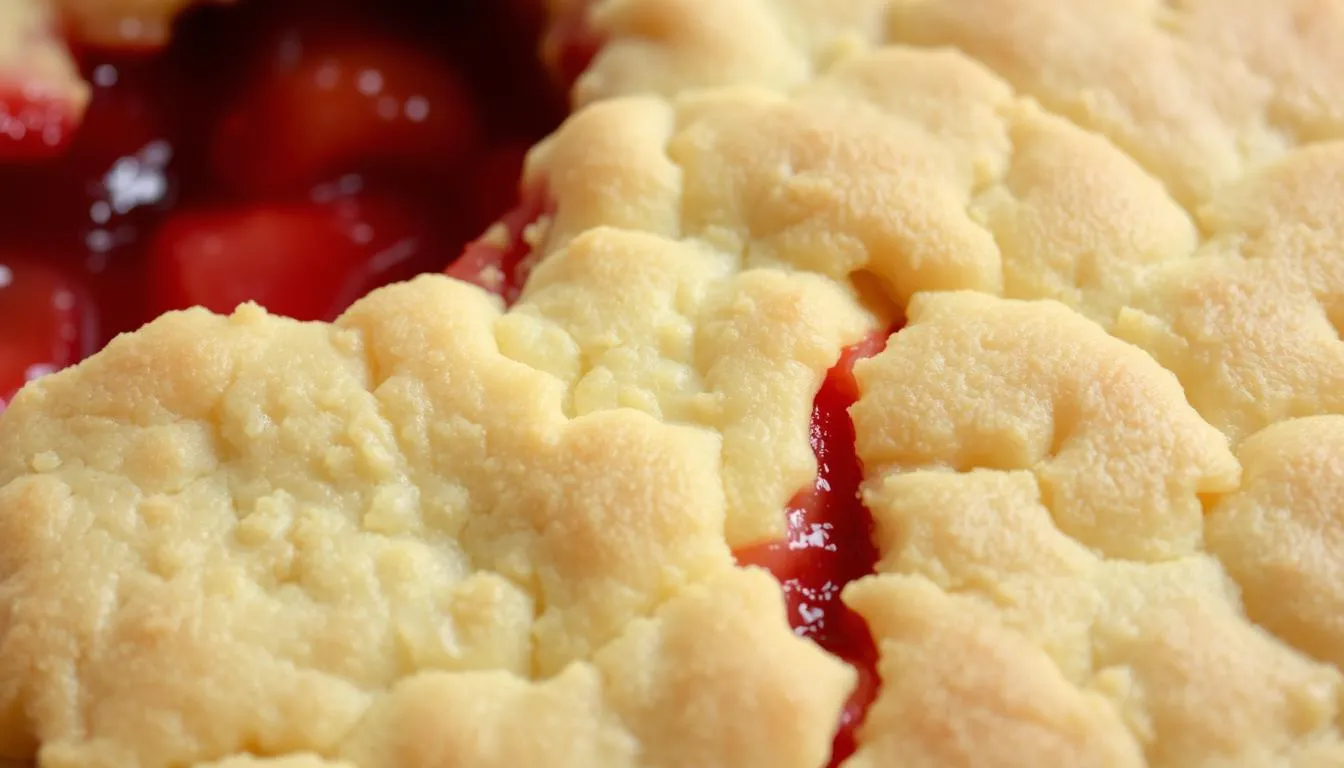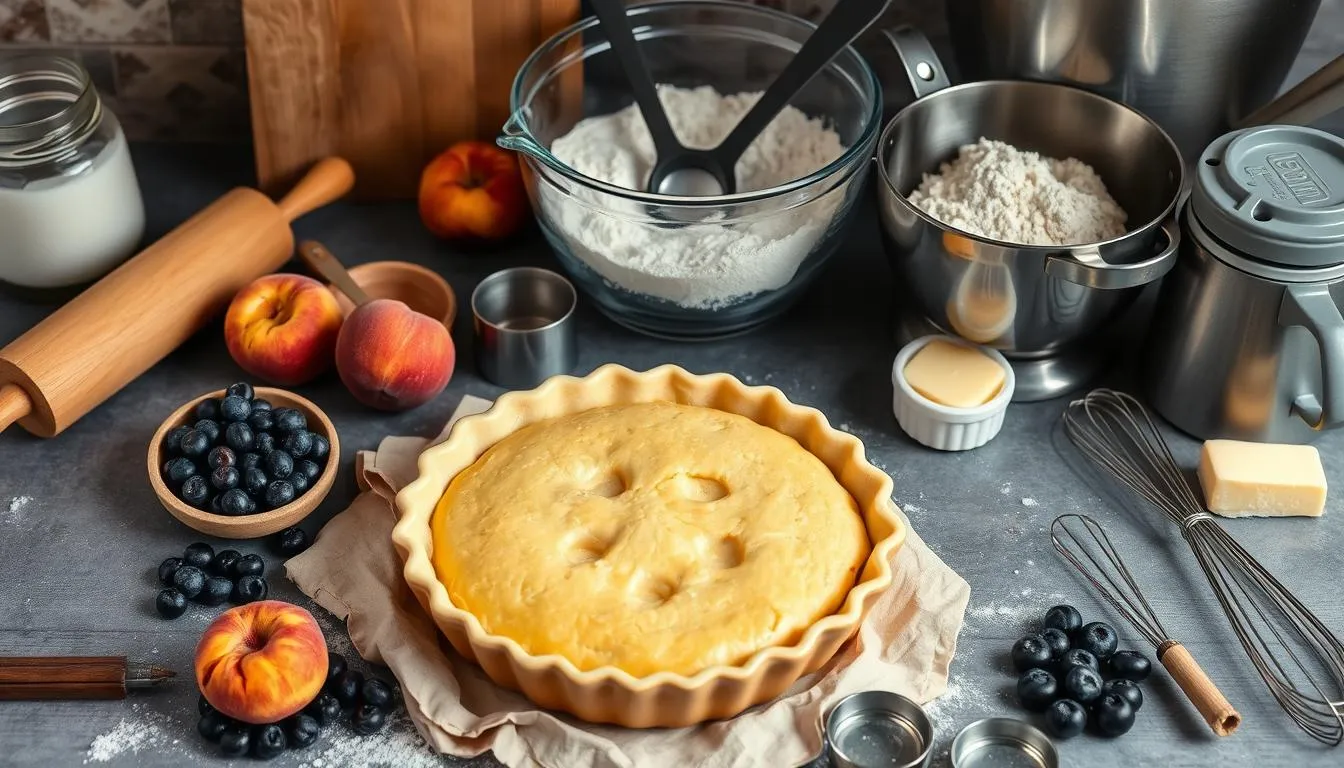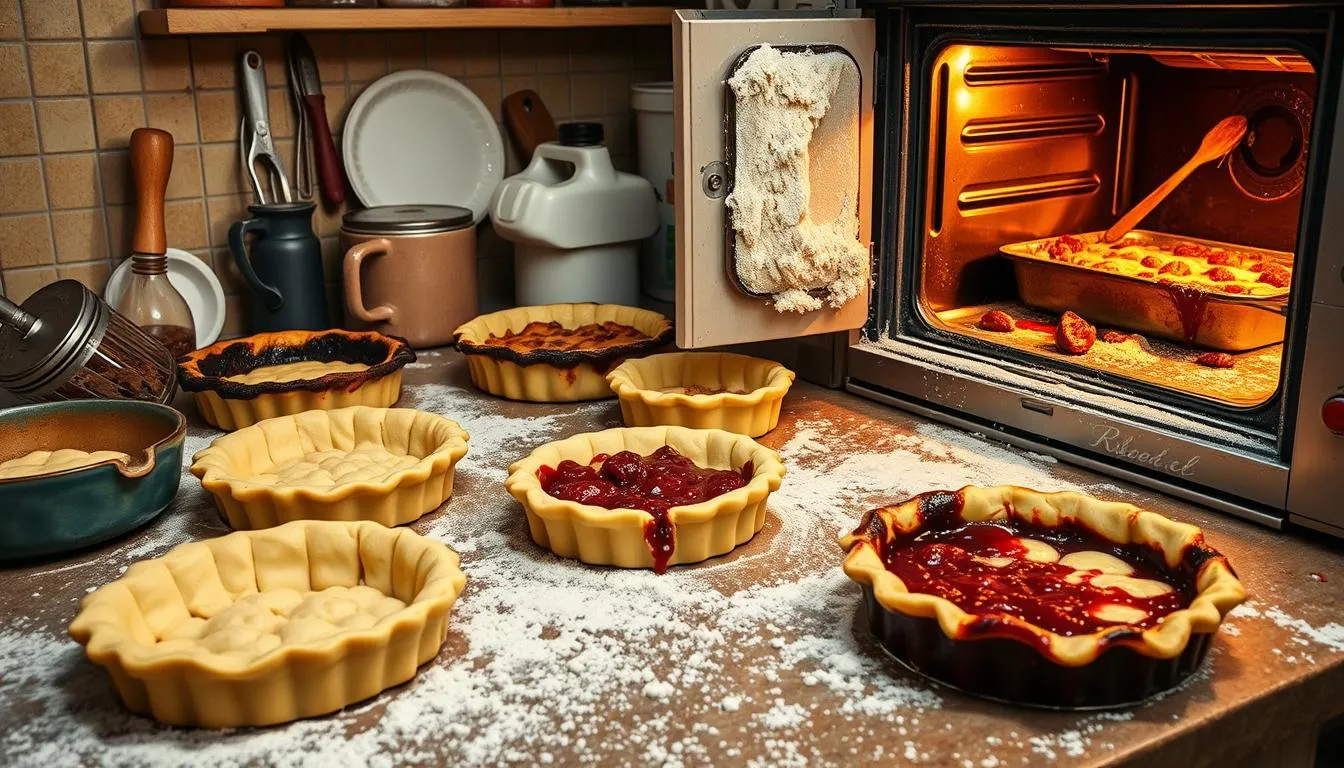Making a delicious cobbler crust is a beloved tradition in American desserts. This homemade topping turns simple fruit desserts into amazing treats. Knowing what goes into a cobbler crust is essential for mastering this dessert.Cobbler Crust: What’s It Made Of?
A fruit dessert crust is more than just a topping. It’s a symbol of comfort and creativity in baking. Cobbler crusts have been warming hearts and satisfying sweet cravings for generations, from Southern kitchens to Midwestern family gatherings.
The secret to a perfect cobbler crust is its simplicity and versatility. Bakers can make this tasty layer with basic ingredients found in most homes. This makes it a treat for both new and seasoned cooks.
Key Takeaways
- Cobbler crust is a quintessential American dessert element
- Simple ingredients create extraordinary flavor profiles
- Homemade cobbler topping reflects regional baking traditions
- Understanding ingredient interactions is crucial for success
- Cobbler crusts offer flexibility in preparation and style
Understanding the Basic Components of Traditional Cobbler Crust
Making the perfect cobbler crust starts with knowing its key parts. Each part is important for a dessert that tastes great and wows your guests.
The base of a great cobbler crust is the right ingredients. Professional bakers focus on mixing these ingredients with care.
All-Purpose Flour: The Structural Backbone
All-purpose flour is the main part of cobbler crust. It makes the crust tender and flaky. Bakers measure it carefully for the right texture.
- Creates essential structure for the crust
- Provides a smooth, consistent texture
- Helps bind other ingredients together
Cold Butter: The Secret to Flakiness
Cold butter is key for a light, flaky crust. When mixed with flour, it makes steam pockets in the crust. This makes the crust tender and delicious.
“The key to a perfect crust is keeping your butter ice-cold and working quickly.” – Professional Pastry Chef
Balancing Sugar and Salt
The right mix of sugar and salt makes a great crust. Salt adds flavor, and sugar adds sweetness. This mix is perfect with fruit fillings.
| Ingredient | Purpose | Typical Amount |
|---|---|---|
| All-Purpose Flour | Structural Base | 2 cups |
| Cold Butter | Create Flakiness | 1/2 cup |
| Sugar | Add Sweetness | 2 tablespoons |
| Salt | Enhance Flavor | 1/4 teaspoon |
Learning about these basic cobbler crust parts will improve your baking. It will make desserts that everyone will remember.
What is Cobbler Crust Made Of?
Making the perfect cobbler crust is all about choosing the right ingredients. These ingredients come together to create a delicious texture and taste. Knowing what goes into a cobbler crust is key to making a tasty dessert.
- All-purpose flour
- Baking powder
- Granulated sugar
- Salt
- Cold butter
- Milk
Each ingredient is important for the cobbler crust’s texture. Baking powder makes the crust light and fluffy. Cold butter and milk mix to make a tender base that goes well with the fruit.
“The secret to an amazing cobbler is in the balance of its ingredients” – Southern Baking Experts
Bakers try different ingredient ratios to find their perfect cobbler. Some like it cake-like, while others want a crispy, golden top that breaks apart nicely.
| Ingredient | Purpose | Quantity (Standard Recipe) |
|---|---|---|
| All-Purpose Flour | Provides structure | 1 1/2 cups |
| Baking Powder | Leavening agent | 2 teaspoons |
| Milk | Adds moisture | 1/2 cup |
Knowing about cobbler crust ingredients helps home bakers make a delicious dessert. It’s a fun journey for both new and experienced bakers.
Different Types of Cobbler Crusts Across American Cuisine
American cobbler styles show a wide range of crusts. Each recipe reflects local traditions and what’s available in the area.
The art of cobbler crusts is a favorite among home bakers. It spans several styles that excite people all over the United States.
Drop Biscuit Style Crust
The drop biscuit crust is a rustic choice. It has a rough texture and is:
- Simple to make with little mixing
- Creates a golden-brown, craggy top
- Made with buttermilk or cream
Pie-Like Pastry Crust
This crust looks like pie dough. It offers a more refined cobbler experience. It’s made with:
- Cold butter
- All-purpose flour
- Exact cutting techniques
“A perfect pie-like cobbler crust should be flaky, tender, and melt in your mouth.” – Southern Baking Quarterly
Cookie-Style Topping
The cookie-style topping adds a nice crunch. It’s crisp and sweet. This part involves:
- Creaming butter and sugar
- Adding flour for structure
- Making a crumbly, cookie-like layer
Regional cobbler recipes keep changing. They celebrate local ingredients and creativity in American kitchens.
The Science Behind Perfect Cobbler Crust Texture
Making the perfect cobbler crust is a science. It’s about mixing ingredients in a special way. This turns simple parts into a baking masterpiece.
Gluten is key to the crust’s texture. When flour and liquid mix, proteins form a strong structure. Careful mixing stops these proteins from getting too strong. This keeps the crust tender, not tough.
- Butter melting temperature is crucial for flakiness
- Cold butter makes steam pockets in the crust
- Even fat distribution leads to a smooth texture
The Maillard reaction changes the crust’s look and taste. It happens when proteins and sugars meet heat. This creates the golden color and rich flavor we love in cobbler crusts.
“Baking is a science, and the cobbler crust is its most delicate experiment.” – Professional Baker
Fat distribution is what makes the crust special. Cold butter, cut into flour, melts to create flaky layers. This is what makes cobbler crusts famous.
Keeping ingredients cold and baking at the right temperature is essential. Each step is a precise part of making perfect pastry.
Essential Tools and Equipment for Making Cobbler Crust
Making a perfect cobbler crust is not just about skill. It also needs the right tools. Professional bakers say the right equipment makes a big difference.
Starting a cobbler is easy with the right tools. Let’s look at what every home baker needs.
Must-Have Mixing Tools
For a tasty cobbler crust, you need the right mixing tools. A pastry blender is key. It mixes cold butter and flour fast and well.
- Pastry blender with sturdy wire loops
- Large mixing bowls
- Measuring cups and spoons
- Silicone spatula
Baking Dishes and Pans
The right baking dishes matter a lot. Ceramic and glass dishes are best. They heat evenly and look great.
- 9×13 inch rectangular ceramic dish
- Deep-dish pie plates
- Cast-iron skillet for rustic cobblers
Temperature Control Equipment
Getting the temperature right is crucial in baking. An oven thermometer is your best friend. It helps you get that perfect crust every time.
“Baking is a science, and temperature control is your most important experiment.” – Professional Baker’s Wisdom
Get reliable temperature tools for consistent, tasty results in your cobbler baking.
Common Mistakes to Avoid When Making Cobbler Crust
Making the perfect cobbler crust can be tricky. Many bakers face common mistakes that can ruin their dessert. Knowing these mistakes is key to making a delicious treat that will wow everyone.
One big mistake is overworking the dough. When you mix the dough too much, it becomes tough and chewy. Instead, mix ingredients just until they come together and handle the dough gently.
- Avoid excessive kneading or mixing
- Use cold hands or pastry tools
- Stop mixing when ingredients just come together
Using the wrong temperature for ingredients can also mess up your crust. Make sure your butter is ice-cold. Warm butter leads to a greasy, dense crust that’s not light and crispy.
| Mistake | Consequence | Solution |
|---|---|---|
| Warm Butter | Greasy, dense crust | Use refrigerated butter, cut into small cubes |
| Overbaking | Dry, burnt crust | Monitor oven temperature, use timer |
Another big mistake is overbaking. Keep an eye on your crust while it’s baking. A golden-brown crust is perfect, but it needs the right timing and temperature. Aim for a light golden color that indicates a crisp, flavorful crust.
“Baking is a science, and precision is key to creating the perfect cobbler crust.” – Professional Pastry Chef
By avoiding these common mistakes, you’ll make a dessert that will be loved by all. Remember, practice, patience, and attention to detail are crucial for a great cobbler crust.
The Role of Temperature in Cobbler Crust Success
Making the perfect cobbler needs careful attention to temperature at every step. The right temperature is key to a crust that’s both delicious and impressive.
Cold Ingredients Matter
Using cold butter is a game-changer for your cobbler. Cold butter creates tiny pockets of fat that melt in the oven. This makes the crust light and crispy.
- Keep butter refrigerated until just before use
- Cut cold butter into small cubes
- Work quickly to prevent butter from warming
Optimal Baking Temperature
The right baking temperature is crucial for your cobbler. Most recipes suggest a temperature between 350-375°F. This ensures even cooking and a golden crust.
| Baking Temperature | Crust Results |
|---|---|
| 325°F | Pale, undercooked crust |
| 375-400°F | Perfect golden-brown finish |
| 425°F | Risk of burning |
Cooling and Setting Time
Cobbler cooling time is key for the perfect texture. Let your cobbler rest for 30-45 minutes after baking. This helps the filling set and prevents it from being too runny.
“Patience is the secret ingredient in creating the perfect cobbler” – Grandmother’s Baking Wisdom
Pro tip: Use an instant-read thermometer to check your cobbler’s internal temperature. A reading of 200°F means the filling is just right.
Regional Variations of American Cobbler Crusts
The art of making the perfect cobbler crust changes a lot across the United States. Each area adds its own special touch to this favorite dessert. In the South, cobbler crusts are known for being rich and buttery. They wrap around classic fruit fillings with amazing flavor.
In New England, cobbler crusts are lighter and more delicate. They often use local ingredients like maple sugar and berries. The Midwest, on the other hand, favors crusts that are heartier and more rustic. These reflect the region’s farming roots.
- Southern Cobbler Crust Characteristics:
- Thick, buttery texture
- Often includes buttermilk
- Generous sugar coating
- New England Cobbler Crust Traits:
- Lighter, more delicate pastry
- Subtle use of local sweeteners
- Emphasis on fresh fruit pairings
- Midwest Cobbler Crust Features:
- Robust, substantial crust
- Traditional farmhouse-style preparation
- Hearty fruit fillings
| Region | Crust Texture | Signature Ingredients | Flavor Profile |
|---|---|---|---|
| Southern | Dense, Buttery | Buttermilk, Butter | Rich, Sweet |
| New England | Light, Delicate | Maple Sugar, Local Berries | Subtle, Refined |
| Midwest | Rustic, Substantial | Whole Wheat Flour, Cream | Hearty, Comforting |
“Every region tells a story through its cobbler crust, capturing local traditions and family recipes passed down through generations.” – American Culinary Traditions
Knowing about these regional differences helps us see the amazing variety of American cobbler traditions. It turns a simple dessert into a celebration of local food heritage.
Tips for Achieving the Perfect Golden-Brown Crust
Creating a stunning golden-brown cobbler crust needs precision and skill. Professional bakers know that the right techniques can turn an ordinary dessert into a stunning masterpiece.
The secret to a beautiful golden-brown cobbler crust is mastering two key elements. These are egg wash techniques and strategic sugar topping methods.
Egg Wash for Cobbler Perfection
Egg wash is a game-changer for achieving that gorgeous golden-brown color. Different egg wash variations can dramatically impact your cobbler’s appearance:
- Classic whole egg wash for rich color
- Egg white wash for glossy finish
- Egg yolk wash for deep golden hue
Sugar Topping Techniques
Elevate your golden-brown cobbler crust with strategic sugar topping approaches:
| Sugar Type | Visual Effect | Texture Impact |
|---|---|---|
| Granulated Sugar | Subtle sparkle | Crisp surface |
| Turbinado Sugar | Dramatic crystal shine | Crunchy texture |
| Powdered Sugar | Soft, matte finish | Delicate coating |
“The difference between a good cobbler and a great cobbler is often in the details of the crust.” – Professional Baker’s Wisdom
Try out these egg wash for cobbler and sugar topping techniques. They will help you create a truly memorable golden-brown cobbler crust. It will impress your guests and satisfy your sweet tooth.
Conclusion
Making the perfect cobbler crust is an art that blends cooking skills with local traditions. Home cooks can turn simple ingredients into tasty fruit desserts by following the tips in this guide. Each step, from choosing the right butter to baking at the right temperature, makes a big difference.
There’s a wide range of cobbler styles across the United States. Bakers in the South, Midwest, and Pacific Northwest each have their own special crust-making ways. The secret is to stick to basic techniques but also add your own flair and use local ingredients.
Creating a great cobbler takes time, effort, and love. Bakers should try out different flours, butter temperatures, and mixing styles to find their own unique touch. Whether you’re making a classic peach cobbler or trying new fruit mixes, perfecting the crust makes your dessert truly special.
By mixing old traditions with new cooking ideas, home cooks can make delicious cobblers that honor American baking. The path to making the perfect cobbler crust is as fun as the dessert itself. It’s a journey of flavors, textures, and cultural traditions.
FAQ
What are the main ingredients in a traditional cobbler crust?
A traditional cobbler crust includes flour, cold butter, sugar, salt, baking powder, and milk. These ingredients make a tender, flaky topping that goes well with fruit.
How does cold butter affect the cobbler crust texture?
Cold butter makes the crust flaky. When baked, it creates steam pockets for a light, tender crust. Warm or melted butter makes the crust dense and tough.
What are the different types of cobbler crusts in American cuisine?
American cobbler crusts vary by region and style. You can find drop biscuit, pie-like pastry, and cookie-style toppings. Each offers a unique texture and flavor.
What are common mistakes to avoid when making cobbler crust?
Avoid overworking the dough and using warm butter. Also, don’t overbake and measure ingredients correctly. Keeping the dough cold and handling it minimally is key.
How can I achieve a golden-brown cobbler crust?
For a golden crust, use an egg wash or sprinkle coarse sugar on top. Bake at 375-400°F. Watch it closely to avoid burning and get a beautiful color.
Do regional variations impact cobbler crust recipes?
Yes, regional variations greatly affect cobbler crust recipes. Southern cobblers have a softer topping, while New England ones are flakier. Midwestern recipes use local ingredients and flavors.
What tools are essential for making cobbler crust?
You’ll need a pastry blender or food processor, measuring cups and spoons, mixing bowls, baking dishes, and an oven thermometer. These tools ensure a perfect crust.
Can I make a cobbler crust ahead of time?
It’s best to make the crust just before baking. You can prepare the dry ingredients in advance and keep the butter cold. Mix wet and dry ingredients just before baking for the best texture.





